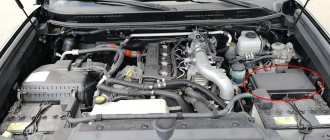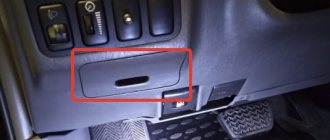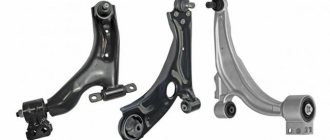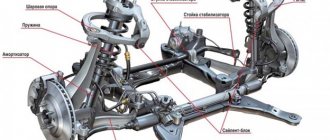Features of Toyota Land Cruiser Prado 150
Toyota Prado is a special series of powerful SUVs. The aggressiveness of the character is emphasized by impressive linings on the rear and front bumpers, symbolism in the design of the wheels, and a special chrome edging for the fog lights.
Technical content
The 2.7-liter gasoline engine is designed for a measured, quiet ride. When using a three-liter diesel engine, increased noise and vibration on the steering wheel and body parts are noted. Owners of previous series will have to get used to the speed-dependent effort function when driving a car.
Most drivers note excessive suspension stiffness. This is fraught with strong shocks in the cabin and longitudinal rocking. It is possible to equip it with air suspension, which “swallows” almost every imperfection of the road surface.
Interior arrangement and body part
According to surveys of car owners, dimensions 4760/1885/1845 create some “bloat”. Deliberate brutality is inherent in most SUVs produced in Japan. The sills are deeply recessed into the body, as a result, clothes are more likely to get dirty in bad weather. The paintwork is of low quality, minimal external influences leave marks.
Large folding mirrors provide excellent visibility. The car is roomy and comfortable for long trips. The soundproofing of the cabin, the ill-conceived location of the start button and the uncomfortable design of the driver's seat receive criticism.
Ride and Handling
Decent adaptive passage of “difficult” road surfaces (dents on the road surface, speed bumps). All kinds of rolls and deviations during driving are minimized thanks to the exchange rate stability system. The off-road function helps you overcome slippery surfaces easily and without slipping.
The steering wheel is informative and responsive. When you pick up speed above 140 km/h it starts to get “heavy”.
Eastern Tiger
The first Land Cruiser Prado model was released in 1984. The current generation is already the fourth generation of this brand. Despite the similarity of names with the Land Cruiser, the car was built on the basis of the mid-size Toyota 4Runner SUV and still retains similarities in the interior and exterior.
The main feature of the Prado is the symbiosis of good cross-country ability with the comfort of a city sedan - this is the main component of the model’s concept, which remains with it throughout all generations.
The fourth generation of Prado under the index 150 was introduced in 2009 and has since been supplied to the European market. The model is a rethought and modernized Land Cruiser Prado 120, with a similar wheelbase. The interior and exterior of the car have undergone changes twice - after being presented at the Frankfurt Motor Show in 2009, the car was restyled in 2013. The exterior, as well as the interior of the car, look impressive and at the same time modest: high-quality materials give them the proper solidity, but at the same time they do not “burden down” the already large car.
The car is produced with both gasoline and diesel units, with power from 173 to 282 hp. With. and volume from 2.7 l to 4 l, with manual and automatic 5-speed gearboxes. From its predecessor, the Prado 150 received permanent all-wheel drive, to which, in the top configuration, the Multi-Terrain system was added, which serves to adjust the suspension to the road surface. There are four modes available for it: stones, gravel, snow and mud. To improve cross-country ability, differential locking is also provided for both the central and rear axles.
The automatic transmission of the Prado 150, similar to the 120 model, provides the possibility of manual shifting. After restyling, the gearbox line was supplemented with a 6-speed automatic transmission, also with the ability to manually change gears.
The main feature of all generations of Prado was their unification with other cars of the brand. The fourth generation also did not escape this fate; many components and parts are similar to adjacent models, which makes it easier to find parts and repair the car.
Front suspension
Despite the company's reputation, the reliability of the iconic Japanese SUV has been questioned. The KDSS ground clearance maintenance system is recognized as the weak link. The cost of repairs can shock unprepared owners.
The KDSS model is simple. The standard rear and front anti-roll bars are hydraulically connected. Communication with the body is carried out through hydraulic cylinder racks.
When driving on level surfaces, the electronics block the circuit using a valve module with a compensation reservoir. By limiting the mobility of the stabilizers, excess pressure is created. The consequence is that the car allows minimal roll when maneuvering.
Let them talk
Car owners speak very positively about it, noting the many positive qualities of the Prado 150. Among the main advantages of this car, drivers highlight:
- high cross-country ability on unpaved sections of the road;
- vehicle reliability and full suitability for use in regions with low winter temperatures (from -30 degrees and below);
- availability of original spare parts and reasonable prices for them;
- high level of comfort for the driver and passengers;
- nice appearance of the car;
However, as with any other car, Prado 150 owners note that it has a number of disadvantages:
- engine power is often not enough for dynamic driving in the city with high fuel consumption;
- plastic trim parts are easily scratched and rubbed;
- car paint is susceptible to scratches and chips;
- easily soiled upholstery;
Despite the presence of shortcomings, all owners of the Prado 150 note the high reliability of the car, high-quality assembly of units and components, high stability on the road and excellent driving characteristics, especially if the driver prefers a more measured driving style.
Checking the front suspension elements
A classic front suspension check includes analysis of 4 elements:
- Lower arm. Check and restore/replace the tightness of nuts and bolts. Examine the part for cracks and deformation.
- Racks. It is recommended to press each of the body corners one by one, releasing them sharply. The rack is in good condition if the body returns to its original position without swaying. A little moisture is acceptable, but it is important not to let the liquid leak. Examine the condition of the upper bushing. Even slight play indicates the need for replacement.
- Coil spring. There are no defects when the position of the car relative to the road surface is normal. If skewed, the spring needs to be replaced.
- Longitudinal thrust. You can replace or restore damage and wear of rubber bushings, the reliability of tightened nuts and bolts.
Every element of the test is important. You need to act according to a strict scheme, step by step.
Front suspension repair
After removing the protection, you should carefully unscrew the racks using a hexagon. Open the stabilization link. Change pads, discs, calipers. On average, wear per 100 thousand kilometers is 1.5 mm. If the anti-squeak plate is worn out, install a new one. When replacing lower control arms, oxidation of the bolts is often detected. In this case, you need to carefully cut them off.
Option for changing the tie rod: tear off the cotter pin in strips on both sides. Unscrew the nut. Unscrew the upper lever, carefully removing the battery. If there is wear on the bolt, replace it. The new one should not be tightened. Unscrew the thrust bearing on the lower ball bearing. Remove the lever by first removing the nut.
Retract the attached steering rod. Remove the shock absorber. Unscrew and clean the cup. Spray with rust preventative. Insert new adjustable shock absorbers and spring. When installing the same shock absorber strut, if the bolts that connect it and the hub bearing housing are tightened, then there is no need to adjust the wheel angles.
Rear suspension
- The rear suspension of the Land Cruiser Prado 150 is independent according to the diagram. It is assembled on a frame and includes levers: trapezoidal lower (spring support);
- transverse upper (the lower ends of the shock absorbers are secured);
- manager.
The latter is designed in such a way that when moving vertically, the wheel track changes within minimal limits. This increases the SUV's stability in a variety of road weather conditions.
The suspension operating on compressed air has the following elements:
- Control indicator. If it is not lit, it means it is turned off; if a malfunction has occurred, it will blink.
- Switch. Changes operating modes. Can turn off automatic control.
- Valve, dryer and compressor.
- Cleaning air filter.
- Sensor for determining the height of the body of the Land Cruiser Prado. The basis is a brush sliding along the receiver, creating a plate.
- Pneumatic receiver and pneumatic cylinder. The latter consists of a chamber filled with high-pressure compressed air. It is used to change the height of the body.
It is strictly forbidden to carry out straightening and welding work on suspension parts. Bolts and nuts with signs of corrosion should be replaced. Do not lift the car by the lower rear frame.
Protection
Additional protection for the Land Cruiser's gearbox, crankcase and engine will help protect these important units from water and dirt getting into them. The installation of such accessories is recommended for all off-road driving enthusiasts, as it will protect the underbody of the car from mechanical damage and extend the life of the car.
The exhaust system of an SUV also needs protection. To do this, the standard pipe is dismantled, and a modified snorkel is installed in its place, which removes gas exhaust at the level of the hood. Off-road tuning for the Prado 150 can be supplemented with a direct-flow muffler. This accessory will increase the power of the car, which will be an additional advantage when traveling over rough terrain.
Standard optics can be protected from accidental damage with special protective grilles. It wouldn't hurt to install an additional front light, which would make night trips safer.
Rear suspension troubleshooting
Auto mechanics note a simpler rear suspension design. But this does not mean less functionality. Variants of faulty elements: levers, racks, silent blocks. Troubleshooting steps:
- Full check of the condition of the rubberized shock absorber bushings. All faulty components are replaced.
- If the adjustment or hub bearings are broken, experts recommend adjusting the preload. Next, the defective bearings should be replaced.
- Bushing fit analysis. If loosening is noticed, tighten the fasteners with several measured movements.
- If one or more leaf springs are broken, replace the entire spring.
- If the axle housing is deformed, replace it.
- Diagnostics of the spring clamp and the strength of its fastening.
To understand whether the front axle is positioned correctly, you need to measure the distance from the reference point on the axle housing to a similar place on the chassis. Re-measure between equivalent points on the other side of the machine. Normally, when the situation does not require repair work, the results coincide by 90%.
Problems
The KDSS indicator lights up on the instrument panel.
The stabilizing device is reliable, but it has its weak point. Sometimes an indicator on the dashboard will light up, indicating a malfunction. This is often accompanied by the appearance of rolls in corners, body distortion, and knocking from the suspension on the driver’s side. Electronic diagnostics with a scanner displays error C1851.
Corroded KDSS Prado 150 block
This happens due to corrosion in the KDSS Prado 150 block. The fact is that in winter, in regions where the roads are sprinkled with chemicals or with frequent off-road driving, water accumulates under the protective casing of the block. This leads to oxidation of the contacts.
To prevent this problem, pre-treat the block with sealant. Also, with the end of winter or after traveling through swampy areas, it is necessary to inspect and clean the electrical connectors from condensation, dirt, and rust.
New block KDSS Prado 150
The manufacturer claims that repairing the CDSS on the Prado 150 is impossible and only involves replacing the units with new ones. To avoid having to pay for such repairs, you need to clean the system from time to time and carry out maintenance on time.
Body alignment
Body skew/roll
Sometimes, after improper repair of the suspension, the Prado 150 with KDSS becomes skewed to one side. You can fix the problem yourself, to do this you need to follow the recommendations:
Place the car on a flat surface. We take out unnecessary things from the passenger compartment, trunk, unloading the car.
The wheels must point straight - this is important. Under the left threshold of the Prado 150 there are two hydraulic units. We need the one that is located closer to the rear suspension.
Opening KDSS trunks. To do this, you need to turn out the shut-off valves 2-3.5 (no more!) turns.
Rock the car up and down several times to stabilize the suspension. Now we measure the difference in heights from the wheels to the edge of the arches
We compare the results of measurements of the rear wheels, then the front ones. The Prado 150 has a permissible difference between the left and right sides of 20 mm.
If this indicator is normal, then tighten the valves and put the protective casing in place.
Prado KDSS “Front”. An additional stabilizer bushing is visible.
Repairing the KDSS seems to be simple, but there are some nuances. Through the technological holes of the protective casing, dirt and moisture enter the valves. Because of this, rust forms, and you have to unscrew the soured bolts with a 5 mm hexagon. In general, you will almost certainly have to suffer.










